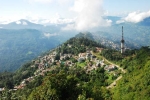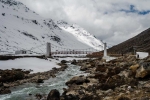Malda Tourism
Ideal Duration : 1 day
Best Time : October to November, February to March
Malda Tourism
If you are in the mood to revisit your roots, Malda is the picture perfect place for you. Located at the confluence of the rivers Mahanadi and Kalindi, in the interiors of West Bengal, about 350 km from Kolkata, the charming town of Malda is popular not only for its mango orchards but also for its rich history and heritage. Malda literarily has Indian History written into every street and every corner of the city. Mango, silk and jute are popular products of the district. Mulberry plantations and mango orchards occupy a large area.
From the Pre-colonial Nawabs to the East India company, Malda enthralls you with visual splendor. Along with history, it also bears the foot prints of religion and beliefs that India has always been living with. Formerly known as the English Bazaar, this town has experienced the reign of three dynasties- the Palas, the Senas and the Nawabs. The different reigns coupled with varying cultures, religions and traditions intensified the charm of the small town as we see today. Scattered with numerous monuments, Malda is one of the most historically relevant cities in Bengal. The folk culture of Malda comprising of 'Gombhira' and 'Kaviyal' is another major attraction of the region.
Download Malda PDF Guide >
What's Great?
Less traffic. Less pollution.
What's not so Great?
Extremely hot in summers. Not very developed. Bad roads in some areas.
For Whom
Malda is one of the most historic towns in Bengal. A popular place for history lovers, Malda attracts a lot of archaeologists too. The summer season, though extremely hot, is delightful for mango lovers.
Gombhira
Gombhira is a socio-religious festival that originated in Malda that celebrates the holy faith of Shiva as it is believed that it brings contentment in this world and salvation in the next. The ceremony is supposedly a pathway to attain particular blessings for his devotees that will purify their soul and guide them on the golden path. The celebrations begin at the end of Choitro (March-April) month marking the end of the agricultural harvest for that year. People wear marks, perform spiritual dance and music, organize feasts to please the deity. It is known by different names in other regions such as Neel-er Jagon in Bangladesh, Gomeera in Jalpaiguri and Shiva Gajon in several southern and western districts of Bengal. But with increasing urbanization in these parts, this art form is dying and now is only observed in very few regions. With changing popular tastes, it is now an almost forgotten tradition in the country.
History of Malda
Forts, architectural marvels, and tales of valour, all in their unique way, bear testimony to the glory that Malda is and was just after it was conceived by the Mauryan Dynasty in 5th Century AD. Located 365 kilometres north of Kolkata, this place was formerly known as English Bazaar in 1771. Once the capital of Gour-Banga the gateway of North Bengal, it is spread over 3456 sq kilometres of land classified into Tal, Diara and Barind popular for attracting explorers and archaeologists round the year. The entire region including the capital cities Gaur and Pandua were part of Pundravardhana empire in the medieval period, which later aggregated with the English Bazaar Town to form present-day Malda. Panini accounted Gourapura town and relics of the Gour kings in the region which dates back its history to the time of Gour Kings in Bengal.
This place holds a symbolic record of its history as it had been the witness of several kingdoms that ruled and flourished by successor kingdoms. Puranic texts indicate that the boundary of Gaur was affected since the beginning of its rule by Mauryas after which it was marked by the rulings several kingdoms and empires. Guptas in 7th century AD, the Pala Dynasty in the 8th century, the Sen Kings in 1204 AD and then the Britishers who regained power over the region in after they won Battle of Plassey in 1757.The result of partition in 1947 brought this region to West Bengal for which they celebrate their independence on 17th of August every year.
One Day Itinerary
Day 1 -Start off your tour early morning with a rejuvenating stroll in the mango orchards. Explore the ruined city of Pandua later in the day. Visit the Jami Mosque and Qutub Shahi Mosque.Day 2 -Learn the history of the town in the Malda museum. Proceed to Gaur in the afternoon. Visit the Firoz Darwaza.Day 3 -Visit the excavated monasteries in Jagjivanpur.
Restaurants and Local Food in Malda
In addition to a variety of Bengali delicacies, Malda is especially known for its varieties of Mangoes, including Himsagar and Gopalbhog. Summer time travellers can especially benefit as the season offers plentiful fresh fruits. Malda also has excellent Bengali desserts to offer, the most popular ones being- Kansat Chamcham and Rosokadamba. Another delicacy to splurge on is the Aamsatwa (sort of mango pulp cake, dried in the sun) made from mangoes, especially the Gopalbhog mango. Fazli is a rich variety of mango know for its thin peel and substantial size with high pulp content is a signature product of Malda District. Originated in the Eastern region of South Asia it is popularly used in tart varieties, flavours up simple dals and winds up afternoon meals in delicious chutneys.
View 3 Restaurants in Malda >>
Oct-Nov, Feb-Maris the best time to visit Malda
October, November and March are the best months to visit Malda. Malda experiences a very hot summer and overflowing monsoons. Though summertime doesn't have any issues, the heat may get overwhelming. Monsoon showers are very frequent and often disruptive. Hence, the early winter and early spring season are the ideal time, owing to the comfortable climate and picturesque backdrop. Winters might also serve as a good time to visit, but only if you're a winter climate lover
Weather in Malda
Loading...
Malda in Summer (March - August)
Summers in Malda are extremely hot and uncomfortable for tourists. The average summer temperature ranges between 25 and 35 degrees Celcius in this season with June being the hottest month. Mangoes are a major attraction in the city in this month.
Malda in Monsoon (July - October)
Malda experiences heavy rainfall in June- July and slight rainfall from October to mid-November. About 70% of the annual rainfall is received during the monsoon season, with July being the rainiest month.
Malda in Winter (December - February)
Malda experiences pleasant winters with foggy mornings and nights.The region has post-monsoon showers which mark the arrival of winters. Temperature varies between 10 and 20 degrees Celcius in this season.
Monthly Weather in Malda
Month
Avg. Minimum (°C)
Avg. Maximum (°C)
January
13
24
February
16
28
March
19
30
April
23
33
May
25
34
June
27
35
July
27
32
August
28
33
September
27
32
October
25
33
November
19
29
December
15
24
Comments on Malda
Post Your Comment


 Dakhil Darwaza
Dakhil Darwaza Gour
Gour Firoz Minar
Firoz Minar Adina Dear Park
Adina Dear Park Gangtok
Gangtok Darjeeling
Darjeeling Santiniketan
Santiniketan Kolkata
Kolkata Murshidabad
Murshidabad North Sikkim
North Sikkim